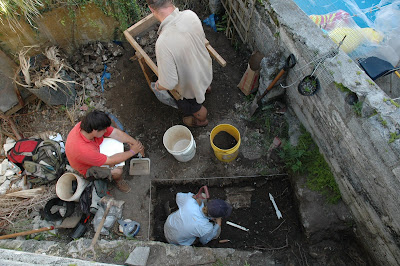It has been a little more than a week since we began our study of St. Peter's Church here in St. George and it has certainly been a very interesting beginning. Our work has taken on various forms, from plan-view survey to subterranean mapping to good, old-fashioned excavation. I have been particularly struck by the nature of our graveyard survey in the St. Peter's churchyard and surrounding areas. I was a bit apprehensive about how my fellow archaeologists and I would be affected by performing an extensive study in such an emotionally-charged site. It seemed to me that we would be operating under a cloud, as it were, as we attempted to gather a useful amount of data from the somber memorials.
I was surprised to find that my original expectations were not realized. Rather than feeling suffocated by the adopted sorrow resulting from hundreds of deaths, I consistently failed to notice the mood of the place. In fact, I often had to stop myself from placing survey materials on the tops of burial vaults, or from leaning against the worn headstones during periods of down-time. For the most part, I was much further divorced from the churchyard's atmosphere that I had initially anticipated. There were, however, several poignant moments during which intense moments of sentimentality, usually the result of an especially emotive inscription or the discovery of a small child's burial, spiked into my general calm, invading what was otherwise a fairly sterile experience. It was at these moments that I was reminded of my surroundings and I immediately felt a wave of guilt sweep over me. How could I forget the loss that had filled these memorials to the point of overflow?
The St. Peter's survey has thus far forced me to reevaluate my notions of emotional archaeologies and the nature of historical places as they are negotiated in the contemporary world. It is my hope, and indeed my expectation, that I will be challenged to continue these ruminations throughout the remainder of our season.
Travis
Travis Parno is a senior staff archaeologist on the St. Peter's Church Archaeological Project and a post-MA PhD student at Boston University.
 We had the Archaeology Open Day yesterday at St. Peter's Church Hall and got a good turn out. The artefacts were on show and the interactive 3D model of the churchyard was available for people to view. Plus the archaeologists gave tours of one of the crypts.
We had the Archaeology Open Day yesterday at St. Peter's Church Hall and got a good turn out. The artefacts were on show and the interactive 3D model of the churchyard was available for people to view. Plus the archaeologists gave tours of one of the crypts.













